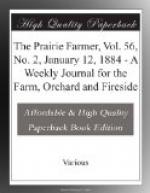POULTRY NOTES.
Poultry-raisers. Write For Your Paper.
A DUCK FARM.
You will not find it on the map because it is not mentioned there, and I shall not tell you where it is because I promised the little woman who owns it, and who gave me permission to tell other women what she had done, that I would not mention her name or the name of the place where she lives and works. How did I happen to find her? I didn’t find her; it just happened—i.e., if anything ever happens in this queer old world of ours. We bumped our heads together once in a railway accident, and we have been firm friends ever since.
Her farm is only a bit of land, some thirty acres, but for the last five years she has made from ten to twelve hundred dollars a year from it, and most of the money came from the ducks. She sells eggs for hatching, and ducks for breeding and for exhibition, but the main object is ducks and feathers for market. She thinks ducks are less trouble and quite as profitable as hens. She keeps twenty-four stock ducks, eight males and sixteen females, through the winter. The ducks commence laying from the middle of February to the first of March, and lay from 100 to 125 eggs each in a season. The first laid eggs are set to get ducks to sell for breeding stock and for the early summer market. For this purpose the eggs from the ducks that are two or three years old are used, and when hatched the ducklings from those eggs are marked by punching a small round hole in the web of the feet. She thinks, and rightly, too, that the eggs from the older ducks procure larger and more vigorous birds than the first eggs from the young ducks.
As soon as the weather gets warm enough to ship without danger of chilling on the way, she sells eggs for hatching at $3 per dozen, and finds no difficulty in disposing of as many as she cares to spare at that price. Her sales of eggs for hatching amount to about $100 yearly. Besides the eggs used and sold for hatching she generally sends a twenty-four-dozen case to New York just before Easter. These large, finely-shaped, pure white eggs sell readily for Easter eggs, and bring from forty to fifty cents per dozen.
From the eggs set on her own place during the season she raises from ten to twelve hundred ducks each year. The ducklings are hatched from the first of April up to about the first of August. Most of the ducklings are raised by hen mothers, and she keeps some fifty hens for that purpose. The hens are all pure Buff Cochins, and are kept until they are two years and a half old. Besides raising two broods of ducks each season, each hen pays her owner an average profit of seventy-five cents a year from the sale of eggs for market. When fattened for market at the end of the second season, these Cochin hens are large and heavy, and the carcass of the old fowl generally sells for enough to pay for a pullet to take her place. No chickens are raised on the farm; the pullets are bought of a neighbor who keeps the Buff Cochins.




